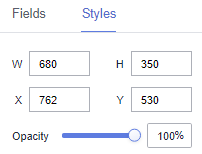This section describes the parameters for a dashboard.
Fields
- In the Data area on the right, select a dataset, and double-click or drag required dimension and metric fields to the corresponding areas on the Fields tab.
- Set a filter.
- Find the data field you need in the dimension and metric lists within the data column.
- Click
 next to the field you wish to filter and you will be directed to the filter settings page.
next to the field you wish to filter and you will be directed to the filter settings page. - Click OK.
Table 1 Filter parameters Type
Parameter
Description
string
Condition
Filter Mode: The options are Condition and Enumeration.
Condition Type: The options are And condition and Or condition.
Filter Condition: The options are Exact match, Contain, Start with, End with, Not match, Not contain, Null, and Not null.
Enumeration
Query Mode: The options are Single-select and multi-select.
Filter Condition: The options are >, ≥, <, ≤, =, ≠, Null, and Not null.
Metric
Condition Type
The options are And condition and Or condition.
Filter Condition
The options are >, ≥, <, ≤, =, ≠, Null, and Not null. You can select Before aggregation and After aggregation for data.
NOTE:If you select Before aggregation, data is filtered before aggregation. If you select After aggregation, data is filtered after aggregation. For aggregation concepts, see Creating a Dataset.
You can click Create Filter Condition to set multiple filter criteria.
Date
Range value
Select a time range for filtering.
Single value
Set a single time for filtering.
Condition
You can select And condition or Or condition as the condition type and select filter condition like >, ≥, <, ≤, and =.
You can click Create Filter Condition to set multiple filter criteria.
- Set the maximum number of query results.
Enter the maximum number of records that can be returned in the text box. The default value is 1000.
- Set automatic refresh.
The auto refresh interval supports the following options: no refresh, 1 minute, 5 minutes, 15 minutes, and 30 minutes.
Style
- Size/Position
- W: width of the target, in pixels.
- H: height of the target, in pixels.
- X: position where the target is located in the canvas. Unit: pixel.
- Y: position where the target is located in the canvas. Unit: pixel.
- Opacity: Adjust the transparency of the target on the canvas using a slider or by manually entering a percentage. A higher percentage means lower transparency.
Figure 1 Size/Position

- Global Style
- Font: font size of the dashboard.
- Dashboard Size: size of the dashboard.
- Divisions: scale of the dashboard.
- Title
- Title: title of the dashboard.
- Font Size: font size of the title.
- Font Width: font width of the title.
- Color: custom title color.
- Axis Color: color and range of the axis.
- Axis Attribute
- Coordinate Axis: width of the axis.
- Axis Scale: length, width, and color of the axis scale.
- Divider: length, width, and color of the divider.
- Axis Label: size, font size, font width, color, and position of the axis label.
- Pointer: pointer attributes. You can select whether to display the pointer on the dashboard. If the pointer is displayed, you can set the pointer length, width, and color.
- Value Labels
- Converting numeric to %: You can customize the value conversion.
- Unit/Font Size/Font Width/Color: You can customize the unit, font size, font width, and color.
- Position: custom position. The horizontal and vertical positions range from -100 to 100.